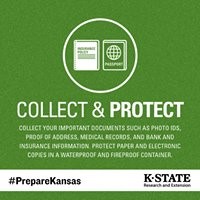September is National Preparedness Month. It is also our annual Prepare Kansas online challenge. Prepare Kansas 2019 will provide tips on keeping food safe in emergency situations.  Kansans and anyone interested in planning ahead for emergencies can follow the K-State Research and Extension Facebook page and this blog at any time during September, pick up handy information and interact with K-State extension specialists and agents. No registration is required. Today’s post is written by Londa Nwadike, State Extension Consumer Food Safety Specialist for Kansas and Missouri.
Kansans and anyone interested in planning ahead for emergencies can follow the K-State Research and Extension Facebook page and this blog at any time during September, pick up handy information and interact with K-State extension specialists and agents. No registration is required. Today’s post is written by Londa Nwadike, State Extension Consumer Food Safety Specialist for Kansas and Missouri.
Once your power has returned and you have breathed a huge sigh of relief, now it is time to assess if your refrigerated and frozen foods are safe to keep or not. The first thing to remember is that you should NEVER taste food to determine if it is safe to eat as you could get sick from consuming potentially contaminated food. And even if food does taste okay, it could still make you sick. However, if you do notice that the food has an unusual color, odor, or texture, you should throw it out as it more likely contains organisms that can make you sick. Another general rule of thumb for food safety in any situation is “when in doubt, throw it out”. We do not advocate wasting food unnecessarily (see for example a KSU fact sheet on what food product dates really mean and our Food Waste website) , but the cost of throwing away questionable food is far less than the potential cost of someone getting sick or dying from eating contaminated food.
If your refrigerator has been without power for more than 4 hours, if your food has not been on ice and if your refrigerator thermometer is reading more than 40F, there are a number of foods that would not be safe to keep as microorgansims that can make you sick could have been growing to dangerous levels while the food was over 40F. A complete list is available from this USDA publication, but some of the key foods that should be thrown out of the refrigerator if the power was out for more than 4 hours include:
- meat, poultry, fish, and eggs;
- luncheon meat and hot dogs;
- casseroles, soups, and pizza;
- milk, yogurt, sour cream, and soft cheeses; and
- cooked or cut/peeled fruits and vegetables.
Also, discard any foods such as bread that may have been contaminated by juices dripping from raw meat, poultry, or fish.
A complete list of foods safe to keep is included in the previously mentioned USDA publication, but in general, foods not included in the list above would be safe.
Many of the same rules that apply to evaluating foods in your refrigerator also apply to foods in your freezer, including “When in doubt, throw it out” and never taste food to determine its safety. The following foods are safe to eat after the power returns to your freezer:
- frozen foods that have thawed, but still contain ice crystals
- foods that have remained below 40F (check your freezer thermometer). They may be safely refrozen, although their quality may suffer.
- foods that don’t actually need to be frozen for safety, such as dried fruits, hard cheeses, and nuts.

